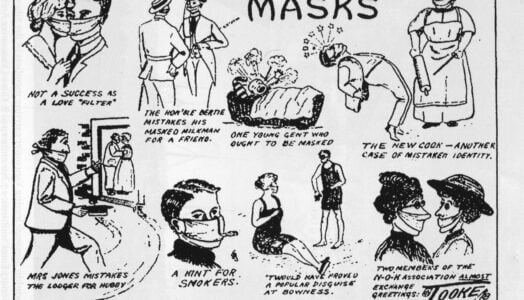Leftist Medical Historian Howard Markel, who also Op-Ed’s for the fake news NY Times and The Globalist, was asked by the Pentagon to study the Spanish Flu pandemic. In 2007, they published the report on non-pharmaceutical interventions during epidemics and found that there was a “layered” effect of protection by using multiple techniques together: school closure, bans on public gathering, isolation and quarantine of the infected, limited closure of businesses, transportation restrictions, public risk communications, hygiene education, and wearing of masks.
From his Conclusions:
CONTEXT
The historical record demonstrates that when faced with a devastating pandemic, many nations, communities, and individuals adopt what they perceive to be effective social distancing measures or nonpharmaceutical interventions including isolation of those who are ill, quarantine of those suspected of having contact with those who are ill, school and selected business closure, and public gathering cancellations.5,6 One compelling question emerges: can lessons from the 1918-1919 pandemic be applied to contemporary pandemic planning efforts to maximize public health benefit while minimizing the disruptive social consequences of the pandemic as well as those accompanying public health response measures?7–10
CONCLUSIONS
These findings demonstrate a strong association between early, sustained, and layered application of nonpharmaceutical interventions and mitigating the consequences of the 1918-1919 influenza pandemic in the United States. In planning for future severe influenza pandemics, nonpharmaceutical interventions should be considered for inclusion as companion measures to developing effective vaccines and medications for prophylaxis and treatment.
Most pandemic influenza policy makers agree that even the most rigorous nonpharmaceutical interventions are unlikely either to prevent a pandemic or change a population’s underlying biological susceptibility to the pandemic virus. However, a growing body of theoretical modeling research suggests that nonpharmaceutical interventions might play a salubrious role in delaying the temporal effect of a pandemic; reducing the overall and peak attack rate; and reducing the number of cumulative deaths.11–15 Such measures could potentially provide valuable time for production and distribution of pandemic-strain vaccine and antiviral medication. Optimally, appropriate implementation of nonpharmaceutical interventions would decrease the burden on health care services and critical infrastructure.
The historical record of the 1918-1919 influenza pandemic in the United States constitutes one of the largest recorded experiences with the use of nonpharmaceutical interventions to mitigate an easily spread, high mortality and morbidity influenza virus strain (ie, a category 4-5 pandemic using the Centers for Disease Control and Prevention February 2007 Interim Pre-Pandemic Planning Guidance).16 Our study focused on this data set by assessing the nonpharmaceutical interventions implemented in 43 cities in the continental United States from September 8, 1918, through February 22, 1919, a period that encompasses all of the second pandemic wave (September-December 1918) and the first 2 months of the third wave (January-April 1919) and represents the principal time span of activation and deactivation of nonpharmaceutical interventions. The purpose was to determine whether city-to-city variation in mortality was associated with the timing, duration, and combination (or layering) of nonpharmaceutical interventions; altered population susceptibility associated with prior pandemic waves; age and sex distribution; and population size and density.
This Pentagon-funded study was intended to come up with only one outcome: find a positive correlation between non-pharma interventions and health, and Markel delivered. Markel’s attempt to jumble some cherry-picked numbers to claim effectiveness is unfounded. Studies were done in 1919 on masks comparing Boston and Stockton, CA with ZERO benefit shown from wearing masks, and quarantines were only effective for harassing immigrants and homeless as shown with the smallpox epidemic of 1893-94.
In another report he claims without proof that: “When influenza appeared in the United States in 1918, Americans responded to the incursion of disease with measures used since Antiquity, such as quarantines and social distancing.” What! There’s no evidence these measures were ever used prior to 1918. The germ theory of disease was just beginning to be propagated so people didn’t live in fear of germs prior to the early 1900’s.




